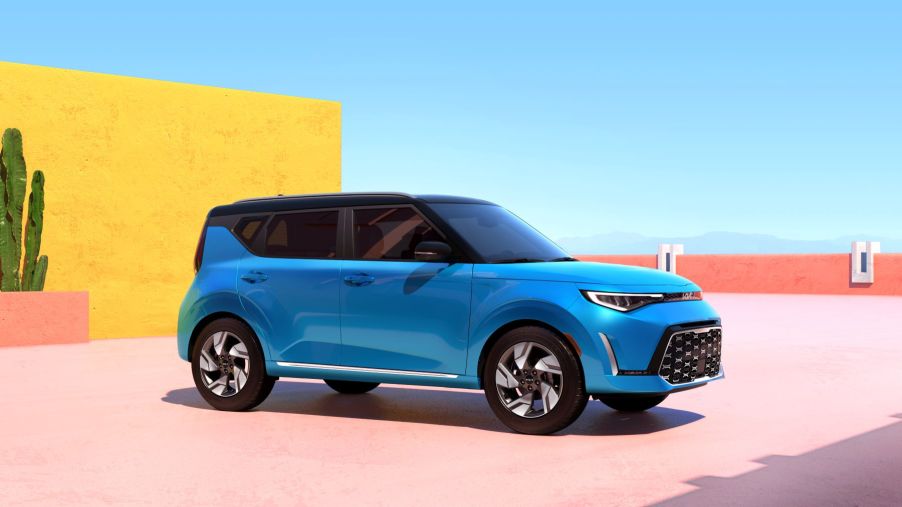
Is the Kia Soul a Hatchback, SUV, or Wagon?
Consumers love the Kia Soul. It’s inexpensive, spacious, and a solid performer. Its popularity has often propelled it to the top of Kia’s line-up in sales. However, one of its most distinctive characteristics has also spurred a lot of confusion. Its boxy shape has critics, prospective buyers, and even long-time owners not quite sure what segment the Soul belongs in. Is it a hatchback, an SUV, or a station wagon?
What makes the Kia Soul so popular?

Beyond its distinctive shape, the Kia Soul has netted a sizable fan base partly because of its fundamentals. The standard model has a decent 147-hp 2.0-liter inline-four engine paired with a CVT. However, if you opt for the top-level trim, the Soul Turbo, you’ll get a 201-hp producing 1.6-liter turbocharged I-4 engine and a seven-speed dual-clutch automatic transmission. The former pairing provides 28/30 mpg city/highway, which is respectable for similar vehicles. Additionally, no matter if you pick the inline-four or the turbocharged I-4, the handling is adept, and the steering is quite responsive
According to Consumer Reports, the Soul provides owners and passengers with a sizable amount of space. There’s ample cargo space: 24.2 cubic feet and 62.1 cubic feet with the second row down. Additionally, the Soul sports a lot of legroom, with 41.1. Inches in the front row and 38.8 inches in the second row. Beyond comfort, Kia provides the Soul with a bevy of conventional amenities, including an 8-inch touchscreen, a six-speaker sound system, and keyless entry. Upgrade to the top-of-the-line Turbo, and you’ll find yourself with a 10-way power-adjustable driver seat, sunroof, heated front seats, and a 10.3-inch touchscreen.
Like other Kias, the Soul comes equipped with Drive Wise – the manufacturer’s suite of advanced safety technologies on X-Line trims and up. However, you can also purchase the Technology package to equip your base model Soul with Drive Wise. If you do, you’ll have access to blind-spot monitoring, automatic emergency braking, lane-departure warning, rear cross-traffic alerts, and a driver focus monitoring system. The Turbo trim also includes adaptive cruise control and Drive Wise.
What segment does the Kia Soul belong in?
If you want to see how the Kia Soul stacks up against its competition, you’ll have to get some clarity on what segment it’s in first. Even some well-known automotive publications differ on that score. If you go to the website Cars, you’ll see the Soul referred to as a versatile hatchback – the same description used by Kia itself.
Elsewhere, if you look at past Edmunds entries, you’ll see the Kia Soul described as a wagon given its boxy build. HotCars refers to the Soul as a hatchback. Carfax calls it a hot hatchback. Car and Driver refers to it as an SUV. So, if even the automotive experts are split in their descriptions, how is a layperson supposed to know what a Kia Soul is? What category does it belong to?
The truth is, the Kia Soul is a subcompact SUV, as per Palmen Kia. While its unique exterior fuels the perception it could belong to any of these other categories, at its core, the Soul’s chassis and powertrain mark it as an SUV, albeit a small one.
Why the confusion on classification?
Kia hasn’t exactly been in a rush to clarify what the Soul is. Why would they? People who think it belongs in multiple categories can attract a broader group of prospective buyers. Still, while its boxy frame blurs easy description, automotive enthusiasts know the difference between a wagon, SUV, hatchback, and a hot hatch.
A wagon, also known as a station wagon, is a vehicle whose body style is marked by a rearward-extended roof covering a cargo area that can be accessed from a door rather than a trunk. Wagons also often have a low floor. Though similar in appearance, a wagon is distinguished from an SUV in that an SUV is fabricated with a light-truck chassis.
A hatchback is also similar to a wagon, though it is generally shorter. A wagon typically has two rows of seating, whereas a hatchback only has one, so a wagon will have fewer windows and pillars. You’ll also find that hatchback rooflines typically dip by the rear door, whereas wagons extend over it. Additionally, a hot hatch is a hatchback whose powertrain has been souped up for high-performance.
The confusion over its categorization has led many consumers looking for a car in each segment to consider the Kia Soul as an option. However, when it comes down to it, the well-liked Soul is actually a subcompact SUV.


